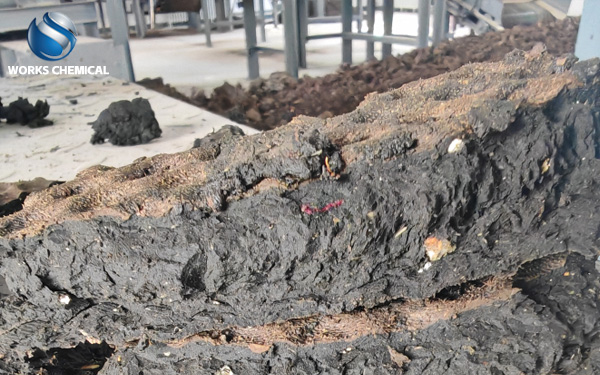
In the treatment of papermaking sludge, the selection of dewatering agents faces multiple difficulties. These difficulties mainly stem from the particularity of papermaking sludge, the limitations of existing agents, and the requirements of the treatment process. The following are the specific difficulties in selection and analysis:

I. The selection difficulties brought about by the particularity of papermaking sludge
High fiber content:
The difficulty lies in the fact that papermaking sludge contains a large amount of long and short fibers. The long fibers are prone to entanglement to form a network structure, which hinders the release of water. Short fibers increase the viscosity of sludge.
Impact: Traditional chemicals are prone to form dense flocs, but they are easily punctured by fibers under high pressure, resulting in fluctuations in the moisture content of the mud cake.
Fillers and adhesives:
The difficulty lies in the fact that the sludge contains fillers such as calcium carbonate and adhesives (like rosin glue). The fillers have a large specific surface area and are prone to adsorbing chemicals. Adhesive substances are prone to wrap sludge particles.
Impact: Reducing the active ingredients of the reagent, increasing the dosage of the reagent, and raising the treatment cost.
Large fluctuations in pH value
The difficulty lies in that the pulping process leads to significant differences in the pH value of the sludge, which affects the stability of the chemicals.
Impact: Under alkaline conditions, aluminum salt agents are prone to form precipitates, reducing the conditioning effect.
Ii. Limitations of Existing dehydration agents
Inorganic salt agents
Representatives: Polyaluminium chloride (PAC), polymeric ferric sulfate (PFS).
The difficulty lies in its limited effect on high-organic matter sludge, and excessive addition can easily lead to a rebound in sludge viscosity.
Impact: In the treatment of papermaking sludge, it is difficult to achieve the ideal dewatering effect.
Organic polymer agents
Representatives: Cationic polyacrylamide (CPAM), anionic Polyacrylamide (APAM).
The difficulty lies in that CPAM needs to be matched with the sludge charge, but the Zeta potential of papermaking sludge fluctuates greatly, making the selection difficult.
Impact: Improper selection of ion degree can lead to loose flocs or reverse dissolution, affecting the dehydration effect.
Compound conditioner
The difficulty lies in the need to simultaneously address multiple demands such as cell wall breaking, flocculation, and filtration assistance, but the formula design lacks specificity.
Impact: The compatibility rate of mainstream compound agents in the market for papermaking sludge is insufficient, and customized development is required.
Iii. Selection difficulties brought about by processing technology requirements
The balance between high pressure and floc stability
When the pressure of the plate and frame filter press is relatively high, ordinary flocs are prone to being crushed, resulting in turbid filtrate.
Impact: It is necessary to develop "rigid flocs" technology to enhance the pressure-bearing capacity of flocs.
The contradiction between feeding speed and mixing time:
The difficulty lies in that rapid feeding can easily lead to uneven mixing of chemicals and sludge, but slow feeding reduces the treatment efficiency.
Impact: It is necessary to optimize the dosing system and the mixing process to ensure that the chemicals are thoroughly mixed with the sludge.
The conflict between Filter cloth Regeneration and Chemical residue:
The difficulty lies in the fact that residual chemicals can easily clog the pores of the filter cloth, but frequent cleaning can affect the continuity of production.
Impact: Advanced filter cloth cleaning technology needs to be adopted to extend the regeneration cycle of the filter cloth.
Four. Dual Constraints of economy and environmental protection
Cost control
The difficulty lies in the large volume of papermaking sludge to be treated and the high proportion of chemical agent costs.
Impact: It is necessary to optimize the selection and dosage of chemicals to reduce treatment costs.
Environmental protection compliance
The difficulty lies in that some agents may release harmful substances and must comply with environmental protection standards.
Impact: Biodegradable agents should be given priority or the agents should be modified harmlessly.
V. Selecting and Optimizing the path
Customized pharmaceutical development
Strategy: Design specialized formulas based on the characteristics of sludge, such as adding cell wall breaking enzymes, high-molecular framework materials, etc.
Application of intelligent dosing system
Technology: Adjust the dosage of chemicals in real time through online monitoring to improve treatment efficiency.
Pretreatment - Chemical synergistic process
Solution: By integrating technologies such as ultrasonic pretreatment and compound conditioning agents, the fiber network structure is disrupted to enhance the dehydration effect.
The selection of dewatering chemicals in the treatment of papermaking sludge faces multiple difficulties. It is necessary to comprehensively consider the characteristics of the sludge, the performance of the chemicals, the treatment process, as well as the requirements of economy and environmental protection. Through strategies such as customized chemical agent development, application of intelligent dosing systems, and pre-treatment-chemical agent synergistic processes, the selection of chemical agents can be optimized, treatment efficiency can be improved, treatment costs can be reduced, and environmental protection requirements can be met.